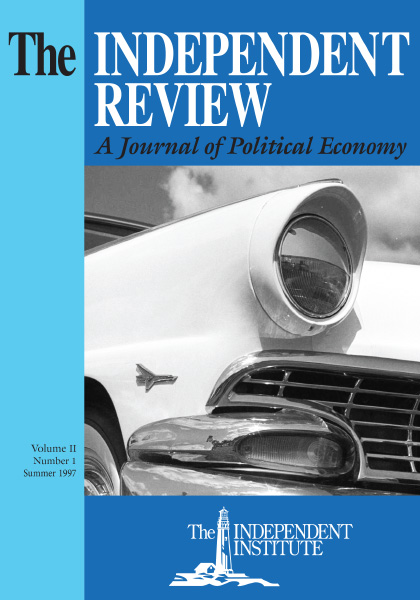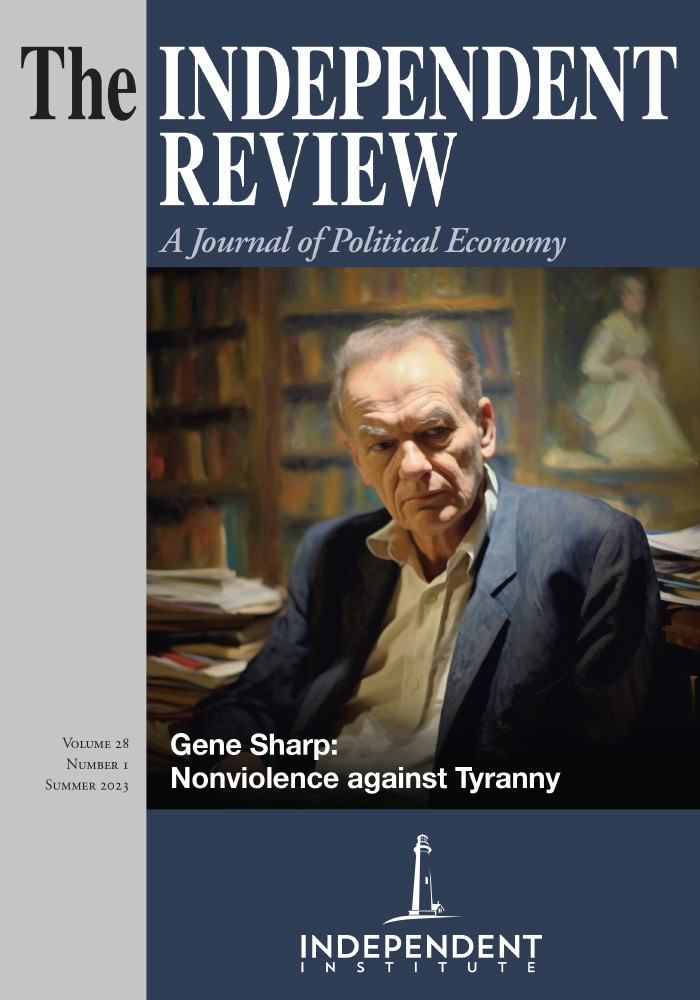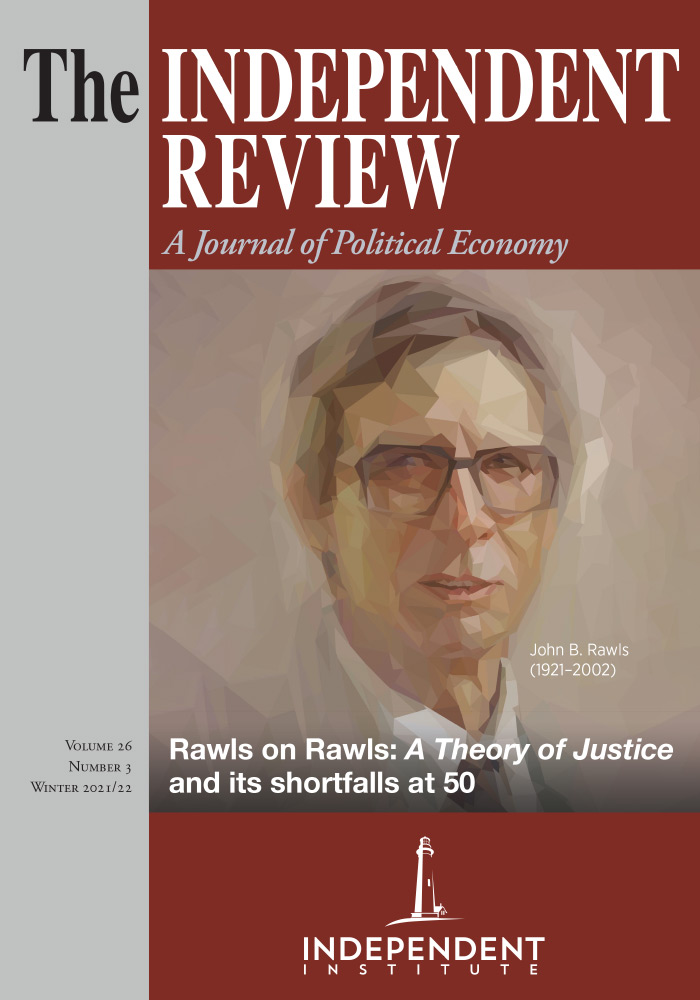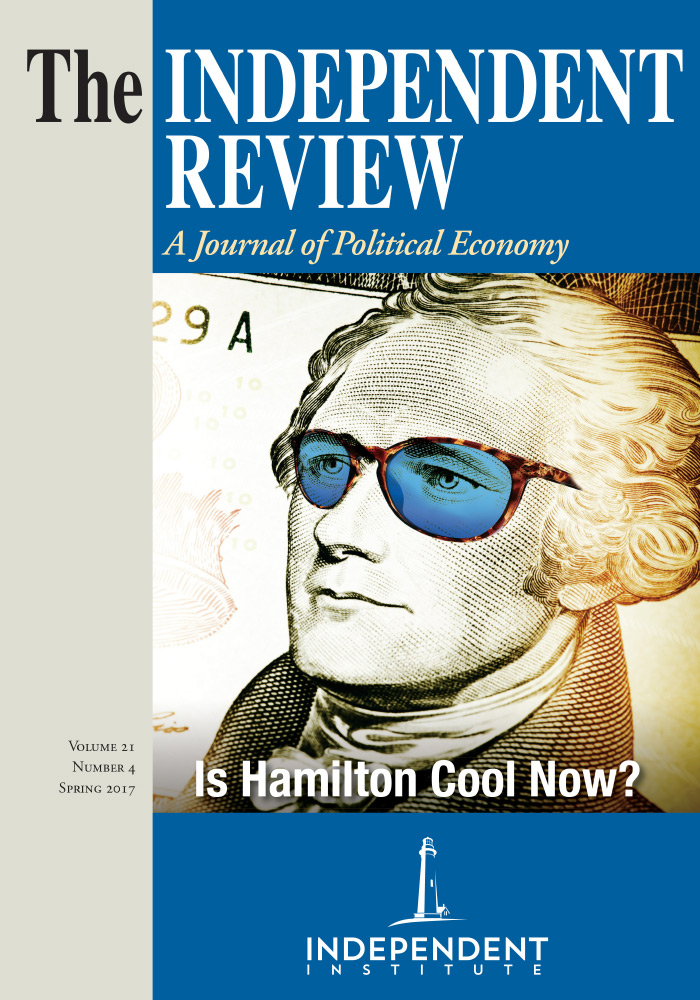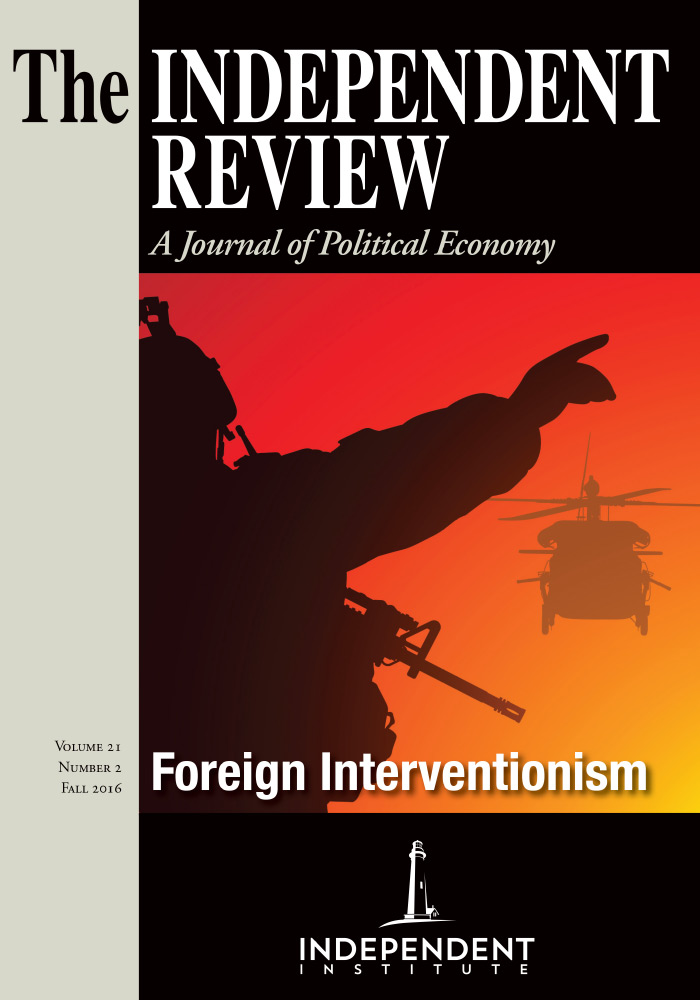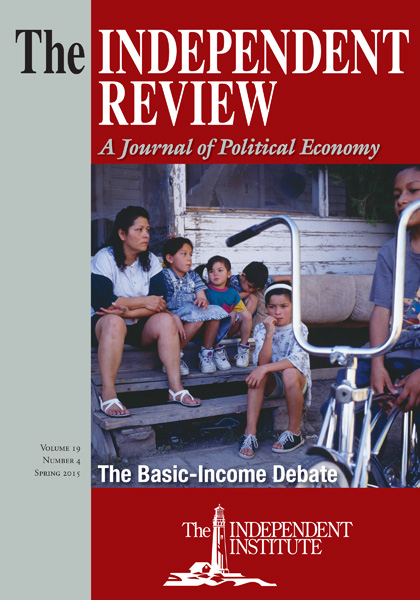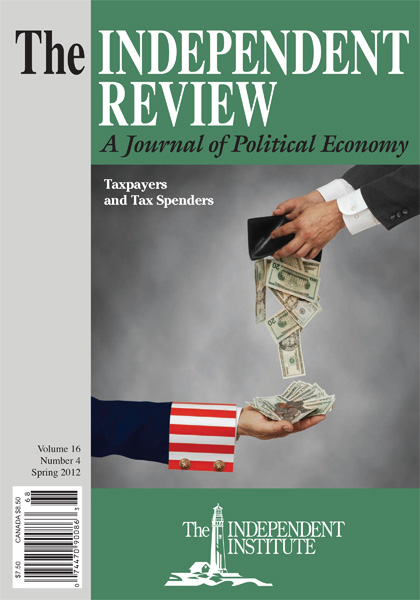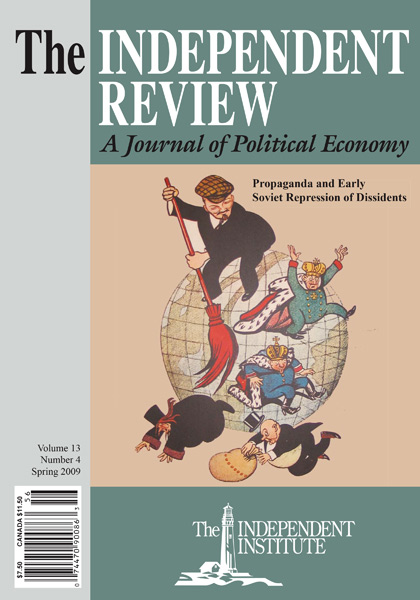Where allowed to operate, private buses and jitneys have demonstrated that the public need not rely on the government to provide transportation services. Assigning rights to use street curbs would give private entrepreneurs even greater ability to give passengers high-quality service.
Article
Urban transit in the United States has long been dominated by government ownership and regulation, and has been declining steadily in ridership and productivity (APTA 1995). An economist-cumpolicymaker would seek to inject competition and entrepreneurship into the sector by privatizing it. The two types of privatization often advocated are contracting out and “free competition” (Department of Transportation 1984; Lave 1985; Gomez-Ibanez and Meyer 1993). Experience has shown, however, that each approach has serious shortcomings.
Contracting out allows government officials to set routes, fares, and the types of vehicles to be used, while putting production and operations in the hands of cost-conscious private companies. Small cities and counties have increasingly contracted out bus service. Larger transit agencies have a harder time establishing major contracting programs, in part because of privileges granted to transit unions. Contracting has reduced costs significantly (Teal 1988, 218ff; Perry, Babitsky, and Gregersen 1988, 134ff), but contracts, even when competitively let, preserve transit monopoly and service regimentation. Transit agencies use various contracting schemes, which Williamson (1976) and Goldberg (1976) have criticized because the methods tend in practice to resemble regulated monopoly.
The second proposal, “free competition,” promises on-the-road competition, perhaps in the form of freewheeling jitneys, which are small vehicles that pick up and drop off passengers along a route but do not necessarily follow a schedule. The deregulation or “free competition” precept is incomplete, however, when applied to a service that operates on government property, namely, the roadway, curbspace, and sidewalk areas where passengers congregate in waiting. Bus operators must invest in cultivating passenger congregations and must be able to appropriate the returns on their investment. Depending on how “free competition” is governed, it might give rise to parasitic interloping on routes, where jitneys run ahead of scheduled buses to pick up waiting passengers. Such interloping might undermine any scheduled service and inhibit the development of transit markets. All this activity takes place on public property where market mechanisms are lacking.
Calls to merely privatize the buses and to deregulate bus operations have neglected crucial issues rooted in the management and utilization of the public domain. They ignore curbspaces as a fundamental resource of the industry. In fact, the rules—property rights—governing passenger pickup areas are a determining feature of transit markets. Variations in curb rights explain the differences in transit markets seen in the United States and elsewhere. An appreciation of curb-rights issues leads to a better understanding of transit markets.
We proceed by first examining four case studies of transit markets with deficient property rights: the jitney episode in the United States, 1914 to 1916; jitneys and route associations in less-developed countries (LDCs); illegal jitneys in New York City; and the British experience of bus privatization and deregulation. These case studies help us to develop a logic of transit operations and to formulate a theory of transit markets. Finally, we propose a system of “curb rights” that promises to improve transit markets.
Transit Markets with Deficient Property Rights
The U.S. Jitney Episode of 1914 to 1916
When the automobile came on the scene, so did freewheeling competition in urban transit. Jitneys charging a nickel per ride picked up waiting passengers along the routes of the electric streetcars. The jitneys were usually just the sedans of the day, serving as shared-ride taxicabs along loosely defined routes. They quickly became popular because of their flexibility and speed—almost twice that of the streetcars. They were more comfortable and less crowded, and sometimes they would deviate from the main route to make courtesy drop-offs. By 1915 jitneys operated in most major cities and reportedly numbered 62,000 nationally (Eckert and Hilton 1972, 295–96; Saltzman and Solomon 1973, 63).
Streetcar companies immediately reported losses due to jitney competition, and many began laying off employees and cutting service. But jitneys did not just interlope on streetcar routes; they also filled important market niches. For the most part jitneys made short trips and provided transportation to many people who otherwise would not have been served by the streetcars. Although jitneys charged no more than the streetcars, their gross revenues far exceeded the streetcars’ loss of revenue (Eckert and Hilton 1972, 296; Rosenbloom 1972, 5).
The jitneys were loosely organized and highly spontaneous. Most jitney drivers were independent, some between jobs or working part-time to supplement their income. Many were simply working people who picked up fares on the way to their regular job. Others were teenagers who borrowed their parents’ car to earn money after school (Eckert and Hilton 1972, 294). Jitneys adapted flexibly as demand changed with the weather, time of day, day of the week, special events, and so on. Despite the decentralized nature of jitney transport, there emerged customs, voluntary associations, and company fleets. The associations helped drivers obtain insurance and share maintenance services and protected the drivers from hostile lawmaking; sometimes the associations coordinated routes and schedules for their members (Eckert and Hilton 1972, 295–97).
The electric streetcar companies saw the jitneys as an infringement on their exclusive franchises and lobbied the government to regulate the jitneys. The municipalities went along with streetcar demands, in part because the streetcars afforded them tax revenue and free movement of police and fire department personnel (Hilton 1985, 37). Municipalities required jitney drivers to obtain substantial liability bonds and operating permits. These measures and other antijitney ordinances proved fatal. The jitneys had largely disappeared by 1917, after just two years of rapid growth and experimentation.
The jitney situation posed a fundamental question of property rights: Is interloping on scheduled service a form of theft or a form of legitimate competition? The authorities decided it was theft, plain and simple, and instead of developing a framework that could accommodate competitive coexistence, they stamped out freewheeling transit in favor of large-scale monopoly.
Jitneys and Route Associations in the Less-Developed Countries
Transit services similar to the U.S. jitneys of 1915 still operate on the streets of hundreds of cities throughout the less-developed world. Takyi (1990) describes the jitney’s appeal to riders:
They charge relatively low fares and provide wide coverage across a city, often serving poor areas that get no other service. Their operations are flexible so they can add service at peak times and quickly cover new neighborhoods. Their small size and cheap labor enables them to profitably provide frequent service in smaller neighborhoods and along narrow streets, as well as work the main thoroughfares. With fewer passengers, they often make fewer stops and faster time. (171)
The American jitneys of 1915 had these advantages until regulations blunted their competitive edge. In the LDCs, laws have been passed to prevent jitneys from interloping on official service and from establishing competing routes, but the enforcement is lax, and, as Takyi (1990) says, the jitneys “never operate legally” (175). Takyi tells of “the loss of passengers at transit stops to jitneys during lean as well as peak periods.”
As jitney service develops in thick transit markets, various curbside conflicts and confusions start to occur. Any operator who attempts to establish scheduled service will face interloping. Some operators will run ahead of the scheduled service; others will linger at the curb to fill up, disrupting traffic and taking ridership from the arriving vehicle (Roth and Shephard 1984, 4; Diandas and Roth 1995, 27–28; Takyi 1990, 167, 175). Consumers may be reasonably well served, but discoordination and lack of trust are often severe (Grava 1980, 285).
Often the jitney operators form a route association, an informal organization to bring order and regularity to service by means of extralegal norms and explicit rules. The jitney literature suggests that route associations have in large measure governed transit services in Lima (De Soto 1989), Hong Kong, Istanbul, Buenos Aires, Manila, Calcutta, and Caracas (Roth and Shephard 1984; Takyi 1990). The route association becomes a regulatory body, similar to government but more local and entrepreneurial. The association lays down rules against interloping and deviating from schedules. It also fixes fares on the route, which may vary with time of day. Associations create enough order to control destructive conflict, but they also operate as cartels. Roth and Shephard (1984, 42), De Soto (1989, 99), Grava (1980, 282), and Cervero (1997, 130, 142) report that associations limit entry.
Thus we arrive again at the issue of rights to waiting passengers—curb rights. Jitneys initially transgressed the curb rights of the official bus operators, yet eventually organized to establish curb rights for themselves. How, then, do they prevent new interlopers from transgressing their rights? Mainly, it seems, by employing physical intimidation and strong-arm tactics. Roth (1987) notes that “the methods used by route associations to protect their territory can become criminal, unlawful, perhaps even homicidal” (224–25). Sigurd Grava (1980) describes route enforcement by means “considerably beyond the law” by “district strongmen,...local bosses, criminal gangs, powerful families, brotherhoods of operators or otherwise legal associations” (282). As is common in black markets everywhere, outlaw entrepreneurs employ violence to maintain their territory. De Soto (1989) tells of route associations in Lima appointing “dispatchers” to monitor compliance with rules, and bribing the police to accost and harass “pirates” trying to invade their route (102).
Once route associations have organized their operations, they often seek official recognition. By lobbying, bribery, petition gathering, and other means, the route associations often acquire official status, receiving permits or licenses. Along with official recognition, however, come political obligations and regulations. Transit history in Colombo (Diandas and Roth 1995) and Lima (De Soto 1989) shows a cycle of transit governance: once the decentralized private operators gain official recognition, they are hamstrung by regulation and suffer invasion by a new generation of interlopers. Without curb rights, established officially or otherwise, orderly scheduled fixed-route service does not last.
Illegal Jitney Vans in New York City
Black-market jitneying is not restricted to the LCDs. In New York City and Miami, jitney vans have operated extensively, interloping at public bus stops and establishing routes of their own. People who ride the illegal vans give a number of reasons for preferring them to the city buses.1 By far the most often mentioned reason is that the jitneys are faster and even cheaper than the city buses. Jitneys also provide a more comfortable ride, with no standing, and many riders enjoy having a driver who speaks their native language. Finally, many riders say that the jitney is safer than the public bus. Because jitneys come more often, riders do not have to wait as long at the bus stop, where one runs a risk of being mugged (Levine and Wachs 1986). Also, jitney drivers will not pick up passengers who are drunk and disorderly or who otherwise bother or threaten the other passengers. Jitney riders, who are mostly members of minority groups, appreciate being able to escape the forced association with all comers that a public bus entails.
Extreme cases of interloping jitneys may develop where market conditions are favorable and enforcement efforts not yet mobilized. To persist once enforcement begins, interloping must expand to a point at which individual illegal operators find safety in numbers, as rioters do. Such jitney outbreaks either continue as a significant force or disappear. In most U.S. cities, either market conditions have not favored illegal jitneys or enforcement has been effective.2 A notable instance of such a jitney outbreak has occurred in New York City. (On Miami’s jitneys, see Klein, Moore, and Reja 1997.)
The transit strike in 1980 prompted modern jitney operation in New York City. Illegal jitneys emerged to provide local service and feeder service to the Long Island Rail Road station in Jamaica (southeast Queens). As Boyle (1993) explains, “the jitneys thrived along busy bus routes...because of the high numbers of people congregated at the bus stops along these routes” (3). Boyle reasons that jitney service has developed especially in neighborhoods of Caribbean immigrants because those riders had become accustomed to relying on jitneys in their native lands. After the strike ended and regular bus service resumed, enforcement against the jitneys was only “sporadic” (Boyle 1993, 3). Jitneys had reached the “takeoff” point to self-sustained operation. The authorities now face the dilemma of cracking down on services that are well regarded by paying customers and treated sympathetically by reporters and news commentators.
To operate legally, the vans would have to obtain special permits and a special insurance policy and undergo multiple inspections each year, and the driver would need a special license. The vans could then pick up and discharge passengers only by prearranged appointment; of course, they could not use city bus stops. It is estimated that between 2,500 and 5,000 vans flout these laws (Boyle 1993, 4).
A public transit executive claimed that each year the jitney vans were diverting $30 million of revenue from public transit (Machalaba 1991). Transit police have been assigned to areas near bus stops to crack down on the interlopers. The New York Times reports: “In the 18 months ended December 1991, a special task force issued 6,542 civil notices of violation against the vans and 11,773 criminal summonses,...[and made] 251 arrests” (Mitchell 1992). Still, the vans are thought to be uncontrollable. A police officer remarks that two or three vans sail by for every one he tickets, and van drivers pay small regard to the summonses. The Wall Street Journal
(Machalaba 1991) reports that over a one-year period the van drivers have been assessed fines of more than $4 million, but the city collected only $150,000. Fear of racial flare-ups dampens the will to go beyond current enforcement measures, which amount to random delays and hassles for the drivers and their patrons.
The New York jitney experience shows again that unsubsidized private enterprise can supply fixed-route transit, even when having to cope with enforcement efforts against the jitneys. We see also that the property right to waiting bus passengers, as well as the degree of enforcement, is a fundamental component in such operations.
Bus Privatization and Deregulation in Britain
The 1985 Transit Act deregulated the British bus industry everywhere except London.3 (In London competition is required only as competitive contracting; there is no on-the-road competition.) All publicly owned bus companies were reorganized as private corporations. The law requires operators to register the commencement of, or changes to, bus service at least forty-two days in advance. The only grounds for local government to refuse to allow a service are serious safety or traffic congestion problems. Local authorities can supplement privately registered routes by putting unserved routes out for competitive tender.
Deregulation permits only scheduled services, not unscheduled services such as jitneys. This restriction, along with the strength of law enforcement in Britain, precludes freewheeling jitney activity and the sort of interloping seen in the less-developed countries.
On-the-road competition was initially strong, but has tapered off to a rather low level (Dodgson 1991, 125; Hibbs 1993, 52). However, one must also consider the question of contestability, or the ability of potential entry to disciplined incumbent firms. Mackie, Preston, and Nash (1995, 232) and Dodgson and Katsoulacos (1991, 265–66) suggest that contestability is constrained by the sunk costs of establishing a scheduled service and by the “economies of experience” held by incumbent operators. Another constraint of contestability, which they do not mention, is the ability of an incumbent firm to react quickly to a competitive challenge. Contestability theory suggests that if an incumbent firm can quickly and easily reduce its fares when a competitor challenges it, would-be entrants might be reluctant to enter, even in a market with high fares (Bailey 1981; Bailey and Friedlander 1982). The challenger can no longer expect to grab market share by offering a lower price, and the incumbent has the advantage of experience, reputation and, in most cases, size.
In fact, British firms have rarely competed by offering lower fares (Dodgson and Katsoulacos 1991, 271–72). Real bus fares increased 17 percent between 1987 and 1994 (White 1995, 198). Instead of competing by offering lower fares, firms chose to offer more frequent service than their competitors. Free competition does not necessarily generate price cutting, as has also been found in deregulated taxi markets (Frankena and Paulter 1986; Teal and Berglund 1987). It seems that information and coordination problems between drivers and potential riders may push transit markets toward a single, or focal, fare rate.
Under the British reforms, registering a scheduled service does not secure one a right to the congregating passengers at the curb. One bus operator can interlope, in a manner of speaking, by registering his own scheduled service, to be provided just minutes before the scheduled service of another. As the law does not proscribe schedule matching, local authorities must allow it. Many British bus operators adopt this strategy, which we call “schedule jockeying” (Dodgson 1991, 126; Dodgson and Katsoulacos 1991, 269; Savage 1993, 146; Gomez-Ibanez and Meyer 1990, 13). Because the established firm has no period secure from schedules of competitors, congregations of passengers waiting at the curb can be snatched up by competitors offering comparable fares. Waiting time so dominates passengers’ travel decisions that any reputation and amenity advantages an incumbent may offer are not likely to keep waiting travelers from taking the first bus to arrive (Weisman 1981; Wachs 1992; Dobson and Nicolaidis 1974).
Incumbent bus companies, however, quickly learned to monitor the registration of new services by competitors using this strategy, and often respond promptly in kind. The forty-two-day registration period makes it easy for firms to monitor each other’s changes in service and to respond in a potentially endless regress. In the face of a mutually destructive battle, the incumbent has often responded simply by scheduling service so frequently that the challenger cannot expect to get enough riders to survive. The practice, known as “route swamping,” has been very common (Dodgson 1991, 126; Dodgson and Katsoulacos 1991, 269; Savage 1993, 146; Gomez-Ibanez and Meyer 1990, 13). The technique has a strategic effect in the immediate contest and in signaling the willingness to use route swamping against future challengers. The ability of incumbent firms to quickly and easily change their schedules in reaction to entry, by virtue of the forty-twoday registration period, constrains contestability in the same way that easily and quickly adjustable prices do in standard contestability theory.
Large incumbent firms often conclude a route-swamping conflict by buying out small rival firms. Also common are mergers between firms that do not compete directly against each other (Mackie, Preston, and Nash 1995, 235; Savage 1993, 147). Many of the latter mergers have taken the form of holding companies, with their subsidiaries often geographically dispersed (Gomez-Ibanez and Meyer 1990, 12–13). The result has been a clear trend toward oligopolistic and even monopolistic operations in the industry, another important unexpected outcome of deregulation (Banister and Pickup 1990, 81; Savage 1993, 147). In many counties just a few firms control over 80 percent of the market (Banister and Pickup 1990, 81). Small operators have been progressively squeezed out of the competitive market, while finding more success in the tendered contract market.
The literature offers numerous explanations for the concentration of the industry. Hibbs (1991, 4) suggests economies of scope and management efficiencies. Mackie, Preston, and Nash (1995, 235–36) and White (1995, 202–3) point to financial advantages of larger firms, managerial economies of scale, and bargaining power. Gomez-Ibanez and Meyer (1990, 12–13) argue that holding companies offer many advantages, including very low costs and the ability to move vehicles and managers from subsidiary to subsidiary as market conditions dictate. They add that firms with large networks have a distinct advantage in the growing use of single-rate, unlimited-travel fare cards. Nash (1988, 110) indicates that larger firms enjoy considerable economies of scope in scheduling buses and avoiding long layovers between runs. Finally, Dodgson and Katsoulacos (1991, 267) point out that to some extent the managers of formerly public firms may have retained their old habit of output maximization despite its inappropriateness for achieving the new goal of profit maximization. The issue of integration might suggest yet another explanation. Dodgson (1991, 124) and Nash (1988) note a steady decline in interoperator ticket availability. White (1992, 56) mentions one case in which the removal of schedule coordination and interoperator ticketing led to a 20 percent reduction in ridership. If firms really cannot negotiate interoperator ticket agreements, and thereby lose ridership, they have an incentive to expand their network to minimize inconvenience to riders.4
Although many of these theories have merit, curb rights are fundamental to the peculiar form of deregulation in Britain. Recognizing that the ability to swamp a route is necessary to combat schedule jockeying, one understands the advantages of larger firms with broader networks. As Gomez-Ibanez and Meyer (1990, 13) point out, a larger company has more supervisors, drivers, and buses at its disposal, which it can shift about to swamp a route where a competitor has commenced schedule jockeying. A larger firm will also have greater financial flexibility to maintain such “fighting fleets” (Dodgson and Katsoulacos 1991, 267, 270). Indeed, the very largeness of the firm presents a formidable warning, signaling potential entrants that entry can and will be met by swamping. Although British deregulation of buses has led to large reductions in costs and public subsidization (White 1995, 194; Mackie, Preston, and Nash 1995, 238; White 1992, 50), it has also yielded a surprising degree of industry concentration, with lackluster competition. Our theory of schedule jockeying and route swamping, rooted in an appreciation of curb rights, helps to explain these developments.
A Theory of Transit Services
The Market Advantages of Jitneys
The American experience from 1914 to 1916 and that of transit markets in some less-developed countries today suggest jitneys have market advantages over scheduled bus service on both the supply side and the demand side. Because jitney operators follow a route but not necessarily a schedule, they enjoy efficiencies in flexibility with respect to their schedules and to changes in weather, congestion, time of day, day of week, and so on. They enjoy flexibility in responding to traffic conditions and can make small deviations from the route. Under a free-entry policy for jitneys, one could expect a cascade of irregular, short-term participants on heavily traveled routes.
On the demand side, passengers waiting for a scheduled bus are generally quite happy to ride a jitney that charges a comparable fare and goes to the same destination. The jitney running ahead offers several advantages. It is available “now,” whereas the bus is yet to arrive. It is smaller and faster; its driver is perhaps more courteous; and it may offer deviations from its route, perhaps at an extra charge. The bus is cumbersome and dreary; the jitney is entrepreneurial, more personalized, and even somewhat charming (Takyi 1990, 165). Still, patrons may prefer to wait for the scheduled bus because it offers more certainty and trustworthiness and perhaps because it is more comfortable than the jitney (Grava 1980, 285). In what follows, we posit that passengers generally prefer to ride in the preceding jitney that charges the same fare as the scheduled service.
Appropriability of the Returns on Investment in Scheduled Service
If, in the presence of scheduled service, jitneys enjoy inherent market advantages, the fate of scheduled service hinges on whether jitneys have free run of the streets. The specification and enforcement of curb rights determine whether jitneying will flourish. In the experience of America in 1915, of ille-gal jitneys in America today, and of jitneying in some LDC cities, scheduled services do not enjoy fully established and exclusive curb rights, either because jitneying is legally permitted or because prohibitions are not enforced.
Where interloping is both prohibited and effectively controlled, bus companies will invest in establishing routes and schedules, publicizing the information, and running the service in an incipient market because they can appropriate the value of these efforts to bring people out to the curb. Although transportation economists have identified no economies of scale in merely expanding bus service (Viton 1981; Shipe 1992; Hensher 1988), they have neglected the appropriability of the returns on investment in setting up and cultivating a route. But firms make specific investments in cultivating a route and schedule, and the appropriability of returns on this investment depends on curb rights. We assume that because jitneys enjoy inherent market advantages, if they are free to interlope they will dissolve any scheduled service. Without the “anchor” of scheduled service, however, fewer riders congregate at the curb and thus fewer jitneys ply the route.
Thick and Thin Transit Markets in the Absence of Curb Rights
Another distinction of fundamental importance is whether ridership on the transit route is potentially heavy enough to sustain the cascade of jitneys in the absence of scheduled service. If the market is potentially thick, a situation may develop in which there is no scheduled service yet jitneys ply the route spontaneously because they have confidence in finding passengers, and passengers congregate at the curb because they have confidence in finding jitneys plying the route. The emergence of conventions that coordinate vehicle services and congregating passengers occurs in America today in the cases of some commuter shuttle vans and carpooling practices (Walder 1985; Cervero 1997, 97).
In an inherently thin market this outcome, even if it occurs, cannot be sustained: there will not be enough passengers for jitney service to be frequent, so waiting times for unscheduled service will be too long to induce passengers to congregate. Because the coordination problem of unscheduled service is severe in thin markets, service might disappear altogether.
The Thick Market: The Jitney Cascade Is Sustained
Consider the case of the potentially thick market with no exclusive curb rights and thus no scheduled service. The horizontal axis of figure 1 counts the number of jitneys per hour that ply the route. The vertical axis counts the number of passengers who congregate at the curb per hour. The thick line shows the number of jitneys that would come out to serve the route, given the number of congregating passengers. This jitneying function shows that no jitneys serve the route when there are no congregating passengers. Once congregation passes a minimal amount, jitneys begin to offer service. In the figure the jitneying response is shown as linear, but it might plausibly be shown as rising at a declining rate because of congestion among jitneys. The thin curve shows the number of people who would congregate at the curb, given the number of jitneys serving the route. It starts at zero, then rises at an increasing rate, but because only so many people have any demand at all for jitney service the curve eventually flattens out.
The curves show the mutual dependence of the two sides of the market. If only sixty people congregate per hour over the course of a week, about 6.7 jitneys an hour will respond. The next week, people expect about 6.7 jitneys an hour, and therefore only about fifty people will congregate. The next week, jitney operators expect only fifty people per hour, and the jitney function shows that therefore the jitneys come out in even smaller numbers, and so on. For a point to the lower left of point Y, the system degenerates to no market at all, point Z. At point Z, a stable equilibrium, it would make no sense for any jitneys to ply the route or for anyone to wait for a jitney.
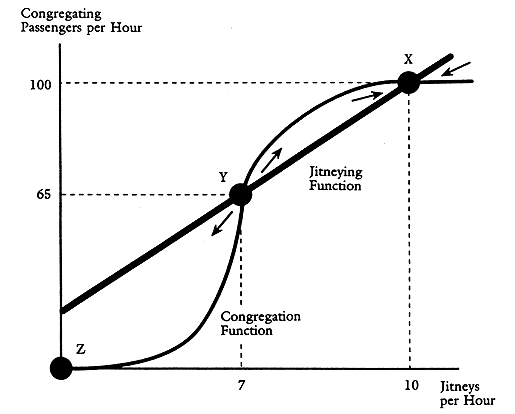
Figure 1. Interactions between Congregating Passengers and Cruising Jitneys in a Potentially Thick Market
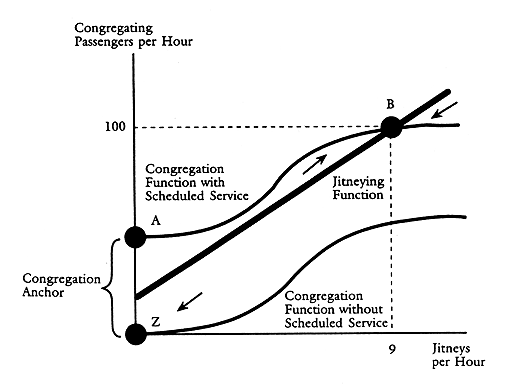
Figure 2. Interloping Jitneys Dissolve the Scheduled Service and Destroy the Market
Suppose that a critical mass were to develop beyond point Y, perhaps due to a transit strike, a coordinated effort by jitney operators, or an unusual event such as the Olympics or a hurricane. In that case the system would maintain its life. If, for example, eight jitneys per hour were to ply the route, that would induce significant congregations, which would induce even more jitneys, and the system would bounce up to the other stable equilibrium at point X. Ten jitneys per hour induce exactly 100 congregating passengers, and 100 congregating passengers induce exactly ten jitneys. This condition is the realization of potential in a thick market.
The Thin Market: The Dissolving Anchor
Figure 2 illustrates the thin market but also posits that the market begins with scheduled bus service. This is the case of the “dissolving anchor.” The scheduled service begins to operate and builds up a market. At first no jitneys participate, perhaps because jitney operators have not seen an opportunity before the development of this market or because they have not tested the powers of enforcement against interloping. With scheduled service and no jitneys, the number of passengers corresponding to point A wait for the bus. This passenger congregation is the “anchor” provided by scheduled service. Assume that for some reason jitneying suddenly becomes possible, perhaps because operators come to recognize that enforcement against interloping is weak or nonexistent. They begin to run ahead of the scheduled service, and many passengers are willing to take whichever vehicle comes first. The relationship between the upper congregation function (with scheduled service) and the jitneying function implies that the system will be driven to point B, where nine jitneys ply the route and 100 passengers wait for service. Passengers and jitneys like this outcome, but because the scheduled bus is now not getting enough riders, it pulls out. The anchor dissolves. Now passengers are less enthusiastic about congregating at curbside, for two reasons. First, they do not have the guarantee of anchor service, so they may have to wait longer or with more uncertainty for a carrier. Second, without scheduled service, there is no longer a focal schedule for arrival times at the stops. Jitney arrival times become less predictable. Hence, when people go to the curb they go with less certainty of when a jitney will arrive, and they wait longer at the curb.5 The decrease in passenger enthusiasm is shown by the shift downward of the congregation function. Nine jitneys per hour now attract fewer passengers. This reduction in turn reduces the number of jitneys, which in turn reduces the number of passengers, and so on. Finally the system settles at point Z, for zilch. Thus, the progression is as follows: we begin at point A with scheduled service; jitneys come to interlope and the system moves to point B; the anchor is dissolved; and then the system moves to point Z, or market disintegration. In a thin market the jitney cascade cannot be sustained.
A Typology of Route-Based Transit Markets
In figure 3 we suggest a typology of fixed-route urban transit. The top-left cell represents unsubsidized buses with exclusive monopolies on routes with moderate to thin patronage. Exclusive rights are established; there is no interloping and no competition. Therefore the scheduled service is preserved. But potential problems include inadequate competition and inert monopoly: the incumbent knows that entry is unlikely and consequently skimps on service or increases fares. Moreover, potential operators will waste resources seeking the “rent” associated with the monopoly privilege (Tullock 1967).
|
Exclusive Route for the Scheduled Service Provider
|
No Exclusive Rights for Scheduled Service
|
No Exclusive Rights and Scheduled Service is Subsidised (and Charged Low Fares) | |
| Thin Market | Scheduled Service Preserved Possible Problems: inadequate competition, inert monopoly |
Interlopers Dissolve Any Anchor Possible Problems: market destroyed |
Scheduled Service Monopolizes Market Possible Problems: franchising problems, subsidy inefficiencies, political conflict, limited flexibility |
| Thick Market (Potentially) | Scheduled Service Preserved Possible Problems: inadequate competition, inert monopoly |
Interlopers Dissolve Scheduled Service, But a Cascade of Jitneys Offers Low-Cost, Unscheduled Service Possible Problems: low quality, irregularity, unreliability, untrustworthiness |
Scheduled Services Preserved, but Jitneys May Serve Excess Demand Possible Problems: franchising problems, subsidy inefficiencies, political conflict. |
Figure 3. A Typology of Fixed-Route Urban Transit
In the bottom-left cell the story is not much different. Again, scheduled service is preserved because interloping is not tolerated. Because the market is thick, it would be better able to support multiple scheduled services, more frequent service, and more consumer choice, but still competition is not tolerated. The problem of inert monopoly is more severe.
The middle cells present conditions without exclusive rights, because they are not granted or not enforced. The entire route is essentially a pure commons. With no impediment to running ahead or interloping, in a thin transit market, shown in the top middle cell, interlopers will run ahead on any scheduled service and collect the waiting passengers. This is the case of the dissolving anchor. The lack of property rights in the waiting passengers results in the “tragedy of the commons” (Hardin 1968). The entire market may be destroyed, for once the anchor has dissolved, people no longer wait and jitneys no longer ply the route.
The case of the thick market is shown in the bottom-middle cell. Here the lack of curb rights may not be a serious problem. Indeed, any scheduled service will be dissolved, but in a thick market scheduled service does not necessarily function as an “anchor.” Combining elements of figures 1 and 2, visualize the lower congregation function (without scheduled service) in figure 2 as intersecting the jitneying function as does the congregation function in figure 1. The market is thick enough to sustain the cascade of jitneys, and riders will be satisfied by flexible, low-cost, and frequent service. This outcome has sometimes occurred: in the American jitney experience of 1915, a few markets in America today (both illegal and legal), and many of the LDC transit markets. In any place, however, possible problems with the jitney cascade outcome include low quality, irregularity of service, high uncertainty of terms, and lack of trust.
A case that does not fit into the typology but which would go between the first and second columns can be imagined. In the British deregulation experience, bus operators enjoy neither exclusive monopolies (column 1) nor operate on a pure commons (column 2). Rather, free competition is permitted among providers who register schedules in advance. The situation is not that of the pure commons because freewheeling is not permitted. The British example suggests that nuanced approaches can be fashioned to fit between the two extremes of exclusive monopoly and pure commons. We will pursue this idea and propose a property-rights framework that avoids monopoly by refining rights along a route.
In the cases considered so far, we have assumed that service providers receive no subsidies. Now consider the case in which scheduled service does receive subsidies (notably government subsidies, but much of the reason-ing applies also to cross-subsidies). Subsidies usually lead to very low fares. When subsidized service is combined with exclusive curb rights, conditions are similar to those described in the first column of figure 3. The scheduled service, because it charges low fares, is now even more immune to interloping, so again it is preserved. Inadequate competition and the familiar problems attendant to government subsidization characterize this case.
The third column of figure 3 depicts the results of subsidized, low-fare service without exclusive curb rights. Interlopers are free to run ahead of the scheduled service, but doing so would be futile because patrons decide they will wait for the scheduled bus, which offers a lower fare. For example, in Los Angeles in 1983 private jitneys were allowed to operate on thirty public transit routes. Matching the eighty-five-cent public bus fare, they succeeded initially, but they promptly withdrew when the city lowered bus fares to fifty cents (Teal and Nemer 1986).
In a thick market, shown in the bottom-right cell, the low fares of the scheduled service again will attract riders, but demand might exceed supply. One of the present authors has witnessed transit operations in Shanghai, where low-fare buses are packed sardine-style and jitneys and taxis cater to the excess demand. In this case, jitneys survive because of excess demand and because they offer superior quality (less crowding, speedier service), even though they charge higher fares. Further, jitneys charge according to trip distance, so someone traveling a short distance might find the jitney fare more appealing than the undifferentiated bus fare.
Now, imagine a decision to privatize and deregulate. If public transit subsidies are eliminated, only the first two columns of figure 3 remain. These two options represent the horns of a dilemma. In one case a provider of scheduled service has an exclusive monopoly over the entire route. Without competition, the provider has little incentive for service improvement and innovation, and fares will be higher. In the other case, no exclusive rights exist. The anchor of scheduled service would be dissolved by jitneys, and markets may never emerge. If policymakers are confined to choosing between these two horns, they should choose on the basis of whether the market is thin or thick. If the market is thin, they should choose monopoly because the alternative results in no service at all. If the market is potentially thick, they should choose not to grant exclusive rights to the route and simply allow the jitney cascade to burgeon. This option will bring freewheeling service and competitive energy to the market, whereas the alternative would be inert monopoly.
Even better, however, would be an option that avoids both horns of the dilemma, one with limited exclusive rights, to prevent the anchor from dissolving, and with freewheeling competition on the route.
Governance for Bus and Jitney Services: Curb Rights
The answer lies in a system of curb rights that both guarantees some exclusivity to those who successfully cultivate passenger congregations and fosters the jitney cascade. No specific system of curb rights is necessarily best for all transit conditions. Because each case is unique, local officials ought to use their knowledge of local conditions to create a suitable curb-rights system.6
Spatial Demarcation of Curb Rights
A simple case would combine a scheduled service provider with the jitney cascade. Figure 4 is a schematic diagram showing curb rights demarcated in space and time. Consider first just the spatial component, where exclusionary zones are separated by a distance. The 8:00 column shows four curb zones. When we speak of “curb zones” or “curb rights,” it should be understood that we mean not only the curb but also the adjoining space on the sidewalk and road—in other words, a complete bus stop. The column shows how Company A is granted two exclusionary curb zones where no other operators may pick up passengers. Think of each exclusionary zone as being 200 feet in length, with the bus stop situated at the midpoint. Company A has an incentive to invest in creating passenger congregations at its bus stops. It would establish a route and schedule and be free from interloping. Yet along the same route jitneys meeting minimal safety and insurance requirements would operate, picking up passengers at nonexclusive zones, or commons. At the commons, passengers have an alternative to Company A, because others (including Company A) may stop and offer service.
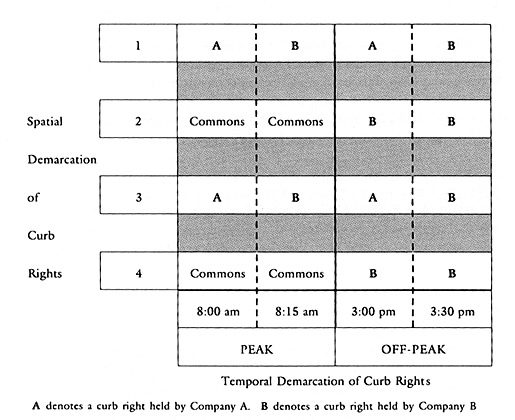
Figure 4. Property-Rights Assignment to Curb Zones
Temporal Demarcation of Curb Rights
Exclusionary zones may also be defined according to time intervals. Consider the two peak-period columns, at 8:00 and 8:15. These illustrate that curb zones may be exclusive for Company A during a fifteen-minute interval and then become the “property” of Company B. This system may make enforcement more difficult, but time-elapsed video evidence could show curb-rights violations. This principle of exclusionary intervals responds to the central failing of the British bus deregulation: the ability of one company to insert its service just ahead of the competitor’s, and hence schedule jockeying and route swamping, which disrupt service and diminish competitiveness in the industry.
In a thin market, giving free play to the jitney cascade might dissipate all service. Off-peak periods often present thin markets. The off-peak times in Figure 4 show an arrangement that precludes jitneys but accommodates competition on the route by granting exclusionary zones first to Company A and then to Company B. Instead of temporal alternation, local authorities might deem it better to have spatial alternation of A and B in the same column. Either way, this competitive arrangement would avoid monopoly, unless the two providers were to collude, and would give each provider an incentive to invest in building its ridership. It forgoes, however, the creative and highly efficient input of the freewheelers.
Auctioning Curb Zones
Now, look at figure 4 and in place of the As and Bs envision dollar signs. The authorities could define exclusive curb zones and simply put them up for sale, perhaps in the form of five-year leases. The leases could be sold at a set price or auctioned. Auctioning the curb rights would avoid the hazard of monopoly power arising from a maldistribution of initial rights (Hahn 1984). The curbspace holder could then have its buses make stops in its leased zones. Under this plan, individuals with local advantages and knowledge of local opportunities could negotiate to make the most of the resource, and the one with the highest valuation would get the curbspace. Further possibilities emerge if the curb rights may be sublet or resold, which we think should be permitted. The holder may then wish to authorize other carriers to pick up in its curbspace in exchange for a monthly rental pay-ment. Or it could sell the lease rights to a provider with a higher valuation of the curbspace.
One can imagine the emergence of professional curb-zone entrepreneurs who lease available zones, sublet pickup rights to carriers, stage passengers and carriers, and monitor and police the curb rights. Such leaseholders could even sublet to jitney associations, but they would manage this competition to protect their interest in their dealings with scheduled buses. Leaseholders could also profit by using the advertising opportunities on transit benches and shelters (Weisman 1984). Our visualization of a curb-rights system includes at least four categories of participants: local officials, curb-zone leaseholders, transit operators (bus companies, jitneys, and so forth), and passengers.
The scenario of a market in curb rights might raise the specter of holding companies or “robber barons” buying all the curb zones and exercising monopoly power over the route. The local authorities could preclude this outcome, however, in a variety of ways. In a thick market the most powerful method is for them to reserve certain curb zones as jitney commons, giving the jitney cascade a potential to compete with scheduled service. In a thin market with a monopoly problem, the authorities could ensure that competing service providers each have their own curb rights.
Enforcement of Curb Rights
Any curb-rights scheme depends crucially on the enforceability of curb rights. Enforceability may not be feasible, but we have good grounds for optimism. In the United States today, only in very exceptional instances, as in New York City and Miami, are the curb rights of official services transgressed at all. In Britain, where the scheduled service is typically unsubsidized, no interloping occurs. Most Americans are law abiding, and local governments can protect curb rights.
Harold Demsetz (1967) has explained how one’s effort to establish and enforce one’s own property rights depends on the costs and benefits of doing so. Local authorities ought to take measures to reduce the costs and increase the benefits of enforcing curb rights. The holder of the curb rights should be encouraged to monitor the “property.” Violation of the rights should be treated as a private tort as well as a municipal violation. Therefore, in addition to depending on municipal enforcement efforts by traffic or transit police, holders of curb rights could, for instance, set up enclosed video cameras to watch for repeated trespass. The video footage of trespassing jitneys would simplify their identification and apprehension and serve as evidence. Technology and official practice are advancing the photographic enforcement of traffic laws (Turner 1995; Blackburn and Gilbert 1995). Furthermore, the drivers of scheduled vehicles could provide eyewitness accounts of running ahead. Suit could also be brought against riders of trespassing jitneys. The holders of curb rights could put up signs at its bus stops: “Boarding an unauthorized vehicle in this zone is a trespass and subject to civil suit.” Travelers would find this reasonable because they could simply walk away from the exclusionary zone to wait legally for a jitney. With a sense of curbspace proprietorship and fair competition, both jitney operators and passengers would be likely to respect curb rights.
Emergence of Staging Areas on Private Property
Jitney commons zones are designated in figure 4, but it might not be necessary to preestablish such zones. It might be sufficient to prohibit jitneys from picking up passengers in the A zones, allowing their own curb zones and staging areas to emerge spontaneously. Local officials may wish to manage the emergence of such pickup spots to avoid sidewalk congestion or to provide transit focal points, but if certain places seem to be emerging as workable jitney spots, the officials ought to smile on the development. They may wish to alter parking or standing rules at such spots and perhaps even to provide turnouts, benches, and shelters. Imagine a McDonald’s restaurant emerging as a jitneying point, where travelers can buy breakfast and organize shared rides on innovative McTransit (Rehmke 1991). If the McDonald’s began to charge for daytime parking or to cooperate in announcing or arranging jitney departures, this activity ought to be regarded as legitimate private enterprise. Throughout the city, entrepreneurs may find it profitable to develop jitney staging areas on private property, and jitney associations may want to negotiate a system of such spots with local businesses. In our scheme, local officials are not primarily regulators; they are creators and enforcers of property rights. Provided that jitney operators and staging entrepreneurs do not tread on the property rights of others, they should be allowed to operate unencumbered.
Conclusion
We have developed a theory of scheduled bus service that recognizes the importance of generating passenger congregations. Furthermore, the returns on investments in cultivating passenger congregations must be appropriable or protected from interloping. Transit markets tend to be gored by one of the two horns of a dilemma. In some markets, scheduled operators can appropriate the value of passenger congregations, but only by means of a grant of exclusive rights not only to the waiting passengers but to the entire route. Thus the first horn is transit monopoly. The other horn is the pure commons, which gives rise to freewheeling competition like that found in some LDC cities. In this case no one cultivates passenger congregations for scheduled service because interlopers will expropriate the investment. In consequence, thin markets receive especially poor service.
|
Exclusive Route for the Scheduled Service Provider
|
Refined System of Curb Rights for Scheduled Service
|
No Exclusive Rights for Scheduled Service | |
| Thin Market | Scheduled Service Preserved Possible Problems: inadequate competition, inert monopoly |
Scheduled Service Preserved; Potential for Competing Scheduled Services; Commons Provides Jitneying Opportunities | Interlopers Dissolve Any Anchor Possible Problems: market destroyed |
| Thick Market (Potentially) | Scheduled Service Preserved Possible Problems: inadequate competition, inert monopoly |
Scheduled Services Preserved and Cascade of Jitneys Offers Low-Cost, Unscheduled Service | Interlopers Dissolve Any Scheduled Service, But a Cascade of Jitneys Offers Low-Cost, Unscheduled Service Possible Problems: low quality, irregularity, unreliability, untrustworthiness |
Figure 5. A Typology of Unsubsidized Fixed-Route Urban Transit Incorporating Curb Rights
A nuanced approach based on property rights can maneuver between the horns of this dilemma. We can have the best of both cases: scheduled service and freewheeling jitneys. Figure 5 revises figure 3 by inserting our solution between exclusive monopoly and the pure commons (and by eliminating the case of subsidized service).
The type of governance suggested here rests on the creation of exclusive and transferable curb rights, leased by auction. Scheduled service providers would have exclusive protection where their passengers congregate, and jitneys would pick up passengers at curb zones designated as commons. Within the property-rights framework of curb rights, entrepreneurs would be free, able, and driven to introduce ever better service, revise schedules and route structures, establish connections among transit providers, introduce new vehicles, and use new pricing strategies. Once the system of curb rights was sensibly implemented, the market process would operate. One feature of this process is competition; another is the discovery of new opportunities for service resulting from entrepreneurial insight into changing local conditions. Within a suitable framework of property rights, the invisible hand will be able to do in urban transit markets what it does so well in other parts of the economy.
Notes
1. This paragraph is drawn from news reports about jitney riders. See Bonapace (1993), Fried (1994), Garvin (1992), Machalaba (1991), and Onishi (1994).
2. Boyle (1993) states: “Transit and planning personnel in Chicago, Los Angeles, Atlanta, and Houston indicate that jitneys were not operating in any extensive or arranged fashion in their cities” (1).
3. Gomez-Ibanez and Meyer (1990), Bannister and Pickup (1990), and White (1995) provide summaries of the 1985 Transport Act.
4. Indeed, many trips using more than one carrier are more expensive than a trip of the same length on one carrier. Hibbs (1991, 5) argues, however, that only a small number of trips involve a change of carrier.
5. It might be thought that once the scheduled service pulls out, the jitneying function would shift outward, because jitneys pick up passengers who had been taking scheduled service. This shift may not occur, however, because passengers are now more randomly dispersed over the course of the hour due to the loss of schedule focus.
6. The hope that local government officials will carry out this task diligently, honestly, and competently must take heed of public choice considerations. But the realm of hope is one of relatives, not absolutes. The public choice pitfalls of government action do not undermine the merit of our proposal when it is viewed in comparison to the status quo or other schemes for government management, because in those other arrangements the same public choice pitfalls apply with equal or greater force. The curb-rights proposal does suffer from public choice pitfalls in comparison to full privatization of not only curb zones and bus stops but the entire system of streets and sidewalks. On the viability of such a plan, see Klein (1997).
References
APTA. (American Public Transit Association). 1995. Fact Book 1995. Washington, D.C.: American Public Transit Association.
Bailey, Elizabeth. 1981. Contestability and the Design of Regulatory and Antitrust Policy. American Economic Association Papers and Proceedings 71 (2):178–83.
Bailey, Elizabeth E., and Ann Friedlander. 1982. Market Structure and Multiproduct Industries. Journal of Economic Literature 20:1024–48.
Banister, David, and Laurie Pickup. 1990. Bus Transport in the Metropolitan Areas and
London. In Deregulation and Transport: Market Forces in the Modern World, edited
by P. Bell and P. Cloke, 67–83. London: David Fulton Publishers.
Blackburn, Robert, and Daniel Gilbert. 1995. Photographic Enforcement of Traffic Laws . Washington D.C.: Transportation Research Board (TE7.N36 #219).
Bonapace, Ruth. 1993. Commuter War: Vans Battle Buses for Riders. New York Times, 14 February, XIII, 1.
Boyle, D. 1993. Jitney Enforcement Strategies in New York City. Paper No. 940642, presented at the 73d Annual Meeting of Transportation Research Board.
Cervero, Robert. 1997. Paratransit in America: Redefining Mass Transportation. Westport, Conn.: Praeger.
Demsetz, Harold. 1967. Toward a Theory of Property Rights. American Economic Review . (Papers and proceedings) 57:347–59.
Department of Transportation, Urban Mass Transportation Administration. 1984. Private Enterprise Participation Program. Federal Register 49.
De Soto, Hernando. 1989. The Other Path: The Invisible Revolution in the Third World . Translated by June Abbott. New York: Harper & Row.
Diandas, John, and Gabriel Roth. 1995. Alternative Approaches to Improving Route Bus
Services in Sri Lanka. Fourth International Conference on Competition and
Ownership in Land Passenger Transport, July, Rotorua, New Zealand.
Dobson, Ricardo, and Gregory C. Nicolaidis. 1974. Preferences for Mass Transit Service by Homogeneous Groups of Individuals. General Motors Research Publication.
GMR-1616.
Dodgson, J. S. 1991. The Bus Industry and the Cases of Australia, the USA, and the UK. In Transportation Deregulation: An International Movement, edited by K. Button and D. Pitfield. London: Macmillan.
Dodgson, John S., and Y. Katsoulacos. 1991. Competition, Contestability and Predation: The Economics of Competition in Deregulated Bus Markets. Transportation Planning and Technology 15:263–75.
Eckert, Ross D., and George W. Hilton. 1972. The Jitneys. Journal of Law and Economics 15:293–325.
Frankena, Mark, and Paul Paulter. 1986. Taxicab Regulation: An Economic Analysis. Research in Law and Economics 9:129–65.
Fried, Joseph P. 1994. A New Law Escalates the War Against Unlicensed Vans. New York Times, 13 February: I, 43:1.
Garvin, Glenn. 1992. Van Ban. Reason 24 (December): 53–55.
Goldberg, Victor P. 1976. Regulation and Administered Contracts. Bell Journal of Economics 7:426–48.
Gomez-Ibanez, Jose A., and John R. Meyer. 1990. Privatizing and Deregulating Local Public Services: Lessons from Britain’s Buses. American Planning Association Journal 9 (Winter): 9–21.
———. 1993. Going Private: The International Experience with Transport Privatization. Washington, D.C.: Brookings Institution.
Grava, Sigurd. 1980. Paratransit in Developing Countries. In Transportation and Development around the Pacific. New York: American Society of Civil Engineers.
Hahn, Robert W. 1984. Market Power and Transferable Property Rights. Quarterly Journal of Economics 99:753–65.
Hardin, Garret. 1968. The Tragedy of the Commons. Science 13 December, 1243–48.
Hensher, David A. 1988. Productivity in Privately Owned and Operated Bus Firms in Australia. In Bus Deregulation and Privatization: An International Perspective, edited by J. S. Dodgson and N. Topham. Aldershot, England: Avebury.
Hibbs, John. 1991. An Evaluation of Urban Bus Deregulation in Britain: A Survey of Management Attitudes. Oxford: Pergamon Press.
———. 1993. On the Move: A Market for Mobility on the Roads. London: Institute of Economic Affairs.
Hilton, George W. 1985. The Rise and Fall of Urban Transit. In Urban Transit: The Private Challenge to Public Transportation, edited by C. Lave. San Francisco: Pacific Institute.
Klein, Daniel B. 1997. Planning, Urban Transit, and the Two Coordinations. Department of Economics, Santa Clara University, Calif. Manuscript.
Klein, Daniel B., Adrian T. Moore, and Binyam Reja. 1997. Curb Rights: A Foundation for Free Enterprise in Urban Transit. Washington D.C.: Brookings Institution.
Lave, Charles A., ed. 1985. Urban Transit: The Private Challenge to Public Transportation. San Francisco: Pacific Institute.
Levine, Ned, and Martin Wachs. 1986. Bus Crime in Los Angeles: II. Victims and Public Impact. Transportation Research A 20:285–293.
Machalaba, David. 1991. Opportunistic Vans Are Running Circles around City Buses. Wall Street Journal, VII 24.
Mackie, Peter, John Preston, and Chris Nash. 1995. Bus Deregulation: Ten Years On. Transport Reviews 15 (3): 229–51.
Mitchell, Alison. 1992. Vans Fighting a Strong Guerrilla War for New York’s Streets. New York Times, 24 January, A16.
Nash, Christopher A. 1988. Integration of Public Transport: An Economic Assessment. In Bus Deregulation and Privatization: An International Perspective, edited by J. S. Dodgson and N. Topham. Aldershot, England: Avebury.
Onishi, Norimitsu. 1994. Bus Fare Dips $1 to Attract Livery Riders. New York Times, 25 September, XII CY, 10:6.
Perry, J., T. Babitsky, and H. Gregersen. 1988. Organizational Form and Performance in Urban Mass Transit. Transportation Reviews 8:125–43.
Rehmke, Gregory F. 1991. McTransit for the 1990s. Econ Update (March): 3f.
Rosenbloom, Sandra. 1972. Taxis and Jitneys. Reason (February): 4–16.
Roth, Gabriel. 1987. The Private Provision of Public Services in Developing Countries. New York: Oxford University Press.
Roth, Gabriel, and Anthony Shephard. 1984. Wheels within Cities: New Alternatives for Passenger Transport. London: Adam Smith Institute.
Saltzman, Arthur, and Richard Solomon. 1973. Jitney Operations in the United States. Highway Research Record 449:63–71.
Savage, Ian. 1993. Deregulation and Privatization of Britain’s Local Bus Industry. Journal of Regulatory Economics 143–58.
Shipe, Richard Thomas. 1992. Cost and Productivity in the U.S. Urban Bus Transit Sector, 1978–1989. Ph.D. diss., University of California, Berkeley.
Takyi, Isaac K. 1990. An Evaluation of Jitney Systems in Developing Countries. Transportation Quarterly 44 (January): 163–77.
Teal, Roger. 1988. Public Transit Service Contracting: A Status Report. Transportation Quarterly 42 (2): 207–22.
Teal, Roger, and Mary Berglund. 1987. The Impacts of Taxi Deregulation in the USA. Journal of Transport Economics and Policy 21 (January):37–56.
Teal, Roger, and T. Nemer. 1986. Privatization of Urban Transit: The Los Angeles Jitney. Transportation 13:5–22.
Tullock, Gordon. 1967. The Welfare Costs of Tariffs, Monopolies and Theft. Western Economic Journal 5:224–32.
Turner, Daniel S. 1995. Video Evidence for Highway Tort Trials. Transportation Research Record 1464:86–91.
Viton, P. A. 1981. A Translog Cost Function for Urban Bus Transit. Journal of Industrial Economics 29:287–304.
Wachs, Martin. 1992. Can Transit Be Saved? Of Course It Can! Keynote address at Metropolitan Conference on Public Transportation Research, Chicago.
Walder, Jay. 1985. Private Commuter Vans in New York. In Urban Transit, edited by
Charles Lave. San Francisco: Pacific Institute for Public Policy Research. Weisman, Mark. 1981. Variables Influencing Transit Use. Traffic Quarterly 35:371–83.
———. 1984. Advertising Transit Shelter Program. Transportation Quarterly 38 (July):361–74.
White, Peter R. 1992. Three Years’ Experience of Bus Service Deregulation in Britain. In
Privatization and Deregulation in Passenger Transportation, edited by A. Talvite, D.
Hensher, and M. Beesley. Helsinki: The University of Tampere.
———. 1995. Deregulation of Local Bus Services in Great Britain: An Introductory Review. Transport Reviews 15:185–209.
Williamson, Oliver E. 1976. Franchise Bidding for Natural Monopolies—In General and with Respect to CATV. Bell Journal of Economics 7:73–104.
Acknowledgments: This article is a condensation of the authors’ book Curb Rights: A Foundation for Free Enterprise in Urban Transit (Washington D.C.: Brookings Institution, 1997). The authors would like to thank Pete Fielding, Pia Koskenoja, Charles Lave, James Nolan, and Ken Small for valuable comments. For financial support, the authors thank the California Department of Transportation (contract RTA-65V450) and the University of California Transportation Center.
| Other Independent Review articles by Daniel B. Klein | ||
| Summer 2023 | The Tao Exposes Slavers to Contempt | |
| Spring 2023 | Instilling Duties above Instilling Rights: Two Features of Adam Smith’s Talk of Justice and Liberty | |
| Summer 2020 | Adam Smith’s Rebuke of the Slave Trade, 1759 | |
| [View All (18)] | ||

